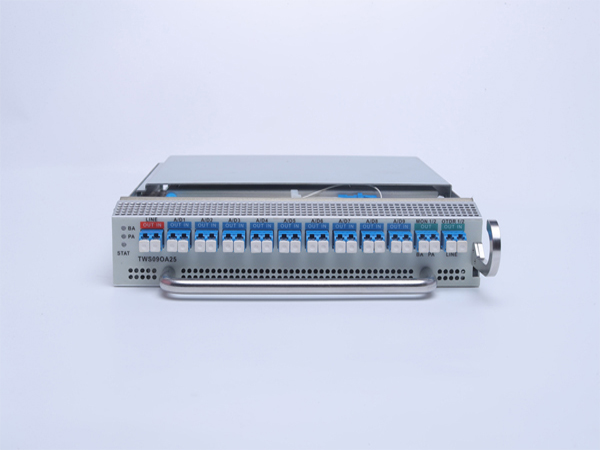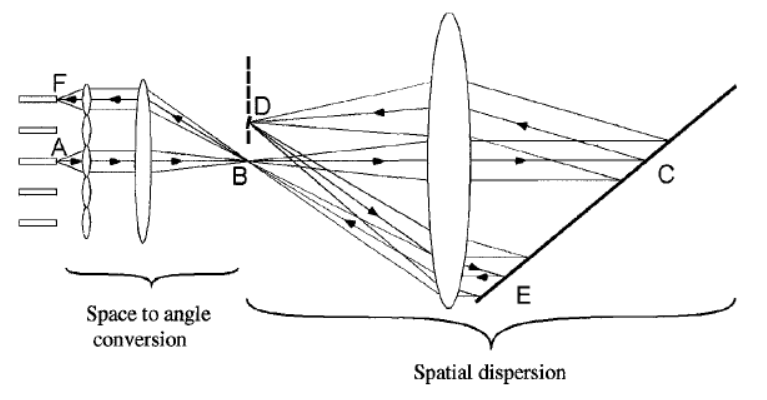

WSS stands for Wavelength Selective Switch. WSS has become the central heart of modern DWDM reconfigurable Agile Optical Network (AOC).
WSS can dynamically route, block and attenuate all DWDM wavelengths within a network node. The following figure shows WSS’s functionality.

The above figure shows that a WSS consists of a single common optical port and N opposing multi-wavelength ports where each DWDM wavelength input from the common port can be switched (routed) to any one of the N multi-wavelength ports, independent of how all other wavelength channels are routed.
This wavelength switching (routing) process can be dynamically changed through a electronic communication control interface on the WSS. So in essence, WSS switches DWDM channels or wavelengths.
There are also variable attenuation mechanism in WSS for each wavelength. So each wavelength can be independently attenuated for channel power control and equalization.
2. HOW DOES A WSS WORK?
There are several WSS switching engine technologies on the market today, here we will demonstrate a MEMS based design. The different switching technologies will be discussed in the next section.
A) 1X2 Configuration
The following figure shows a diffraction grating and MEMS based 1×2 wavelength selective switch.

The light from a fiber is collimated by a lens with focal length f and demultiplexed by diffraction off the grating.
The direction of the beam after the grating will depend on the wavelength λ0 of the beam. The diffracted beams then pass through the lens for a second time, and the spectrally resolved light is focused on the reflective linear MEMS device, which is also referred as 1D (1 dimension) MEMS device. The MEMS device then either changes the amplitude (attenuate) or the direction of the beam.
The reflected light passes through the lens and is wavelength-multiplexed by diffraction off the grating, and finally the lens couples the light back into the fiber. The output light is separated from the input light by a circulator.
B) 1XN Wavelength Selective Switch
The 1XN switch can be considered as a generalization of the 1×2 switch. Because every wavelength in the 1XN switch can be switched to any one of the N output ports, this switch can be used in a fully flexible OADM (Optical Add Drop Multiplexer) with multiple add/drop fiber ports, each of which carries single or multiple wavelengths.
1XN switches can be cascaded to form larger architectures, and NxN wavelength selective matrix can be built by interconnecting back-to-back 1XN switches.
Let’s look at the optical design of the 1XN wavelength selective switch (WSS).

In the 1xN switch design, it uses an additional lens in Fourier transform configuration to perform a space to angle conversion in the first stage of the switch. Also the 1xN switch will require tilt mirrors with N different tilt angles. These are usually implemented as analog mirrors.
Here is how the design works.
1. The common input fiber enters the switch at point A where light is collimated by a microlens.
2. The following lens image the collimated beam on the diffraction grating at point C.
3. The wavelength dispersed beams fall then onto the MEMS device plane D
4. On MEMS device plane D, the beams are reflected with certain tilt angle depending on micromirrors’ setting.
5. All reflected beams are focused on point B again, where the angle to space conversion section will image the beam on the output fiber. Each output corresponds to a specific tilt angle of the micromirrors.
This MEMS based switch can switch as many as 128 wavelengths with 50 GHz spacing. The total insertion loss is less than 6 dB. It uses a 100mm focal length mirror and a 1100 lines/mm grating. The micromirrors can be actuated by +/- 8° using a voltage of <115V and the switch can be used as variable attenuator by detuning the tilt angle of the micromirrors.